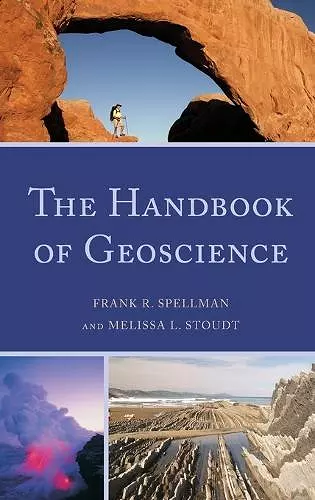The Handbook of Geoscience
Frank R Spellman author Melissa L Stoudt author
Format:Hardback
Publisher:Scarecrow Press
Published:14th Feb '13
Currently unavailable, and unfortunately no date known when it will be back

Written in an engaging and highly readable style, The Handbook of Geoscience is ideal for students, administrators, legal professionals, non-scientific professionals, and general readers with little or no science background. This handbook is a user-friendly overview of our physical, biological, and ecological environment, one that offers up-to-date coverage of the major scientific fields that form the structure of geoscience. Students who are enrolled in a geoscience course or one of its many subdisciplines will find this work an invaluable resource to support and supplement classroom instruction. The emphasis is on readability, with clear, example-driven explanations refined by more than 35 years of experience of instruction and student feedback.
This reference work—a compilation of key facts related to earth science—provides a broad overview of all aspects of geoscience. Authors Spellman and Stoudt possess complementary backgrounds. Spellman earned a PhD in environmental engineering and has written more than 70 books on environmental matters. An expert in the demanding area of radiation controls, Stoudt has provided instruction to naval officers and to technicians at an atomic power laboratory. The authors’ collaboration has produced a reference book notable for its readability and utility. Incorporating relevant math operations and conceptual terminology, the volume surveys the atmosphere, biosphere, hydrosphere, lithosphere, pedosphere, and related areas. Force and motion; work, energy, and momentum; and circular motion and gravity receive their due. Sample entries include Acceleration, Biological diversity, Ecosystem, Evapotranspiration, Geodesy, Lentic habitat, Troposphere, Weathering, and Wind farms. The topically arranged entries range in length from a single paragraph to several pages. Example-driven definitions clarify many concepts. Sidebars provide ballast to the survey; for example, we learn that without plankton, there would be no living organisms on earth. Select black-and-white line drawings, photographs, and illustrations punctuate the text. A listing of references and recommended reading are provided at the end of each section. Appendixes include a 42-page glossary and a 9-page subject index. Undergraduates and general readers will find The Handbook of Geoscience up-to-date, accessible, and reliable. The clarity and economy of language of the presentation will appeal to nonspecialists. The work’s scope and command of data render it a useful addition to general reference collections. * Booklist *
This is the sort of book which should be on the reference shelf of beginning students in the earth sciences, and undergraduates in any of the other sciences. Readers can use it to quickly look up basic terms, definitions, and concepts in geology, meteorology, astronomy, physics, chemistry, and mathematics, whether because they have forgotten them or because they never knew them to begin with. Prolific science writer Spellman (formerly, environmental health, Old Dominion Univ.) and Stoudt (radiation controls training instructor) clearly present most of the material in this large volume (seven parts and 30 chapters). Each chapter ends with a list of references and suggestions for further reading, and there is a glossary and adequate index in the back. Summing Up: Recommended. General readers and lower-division undergraduates * Choice Reviews *
This hefty handbook is designed by the authors as a 'user-friendly overview' of geoscience. They have defined the geosciences broadly, including in their coverage the atmosphere, biosphere, hydrosphere, lithosphere, pedosphere (soils), environmental science, geographic systems, geodesy, surveying, and cartography. The authors stress the 'readability' of the text, and it is indeed written in an attractive style. . . .The variety of topics in this single volume is extraordinary. It begins with the basics like measurements, units, and the scientific method, and then proceeds through the major disciplines of the geosciences, covering a little bit of almost every major topic. There are a good number of black-and-white photographs and several good . . . line drawings. Each section has an extended bibliography. * American Reference Books Annual *
The reviewer recommends the book by Spellman & Stoudt as a good reference on numerous geoscience-related topics. . . .This book will be an ideal gift for the very beginners in geoscience, including undergraduate students, geology/nature amateurs, kids, and policy-makers. However, it should also be appreciated by some professionals - e.g., geologists starting to deal with climate and soils, hydrologists starting to work with minerals and rocks, meteorologists starting to investigate ecosystems, and so on. * Zentralblatt für Geologie und Paläontologie *
ISBN: 9780810886148
Dimensions: 235mm x 164mm x 45mm
Weight: 948g
564 pages